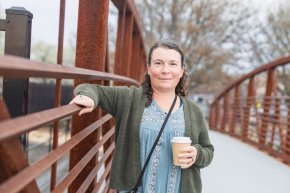
Redefining a Region Through Research

The economic history of Hickory and Catawba County is written on the walls at Lenoir-Rhyne University. Campus buildings share names with many of the magnates who built the manufacturing industry in and around Hickory in the 19th and 20th centuries — Shuford, Moretz, Cloninger, Rudisill, Fritz, Rhyne.
Hickory was incorporated as a city in 1870, only 21 years before Lenoir-Rhyne was founded, so town and gown have grown up together in a very real sense, even as they have followed different trajectories. While LR has experienced relatively stable and consistent development, Hickory has followed a path with greater flux in recent decades as the economy has shifted from one based almost entirely in manufacturing to one with greater emphasis on information and service.
“The formula driving economic development here in Hickory is the same one driving development all over the United States right now, but it’s especially pronounced in small and mid-sized cities throughout Appalachia,” said Katherine Gerlaugh, Ph.D., assistant professor of sociology at Lenoir-Rhyne.
“Pittsburgh, Birmingham, Chattanooga, Greenville — all these cities have used the same logic that Hickory has put in place to revitalize the city,” she added. “Revitalize the downtown area. Make it more attractive to people who like outdoor recreation. Enhance the nightlife options. Improve technological infrastructure and utilities. We’re seeing cities throughout the region making deliberate efforts to grow business and become more attractive to middle-class families.”
The scholar
Specializing in political economy — an area of study that explores the intersection of politics, economics and social structures — Gerlaugh has spent years studying cities that have pivoted from a production-oriented economy to a tourism and service-oriented economy to sustain growth.

“That was the focus of my dissertation at the University of Tennessee, looking at how cities in Appalachia were adjusting to the decline of manufacturing and resource extraction in the region. For example, Chattanooga, Tennessee, was engaged in this process of expanding tourism and service — with high-end restaurants, live music and events, expanded parks and recreational spaces,” Gerlaugh explained. “I’m now taking the premise of that dissertation and applying it to Hickory and the surrounding area.”
Although not from Appalachia originally, Gerlaugh has been steeped in Appalachian culture since her undergraduate days at Centre College in Danville, Kentucky. She lived in Boone, North Carolina, for five years, beginning work on a master’s degree at Appalachian State before transferring to Indiana University-Purdue University in Fort Wayne, Indiana.
“When I left Boone, I knew I would be back in this area, and when I went to Tennessee to do my Ph.D. work, my long-range goal was to move back to Western North Carolina and continue to study Appalachia,” said Gerlaugh. “I also wanted to teach at a small liberal arts college, so joining the faculty at LR perfectly aligned with my research focus and teaching goals.”
The study
Gerlaugh’s research combines an analysis of trends in cities taking deliberate action to refresh their economies, interviews and data investigating how those trends have been adopted in Hickory — and how the local culture and economy are responding to those changes.
Revitalization requires tax dollars for investment in infrastructure, so redevelopment requires buy-in from citizens and deliberate will from local governments.
“For a long time, there really wasn’t much happening in Union Square, downtown. It was pretty empty, but then the city established a farmer’s market and began hosting regional musical acts,” Gerlaugh explained. “Then, in summer of 2019, they essentially remade the whole space of Union Square, which boosted the popularity of the events happening there.”
In 2021, the city also established a social district covering much of downtown, which allows people to consume alcoholic beverages in designated containers — from licensed bars and restaurants — while outdoors anywhere in the district.
The payoff of the revitalization of the downtown area comes with increased consumer traffic, which allows for reinvestment. In recent years, Hickory has landed on multiple lists of the top places to live in the United States, which means growth in the tax base and even more reinvestment.

“On Saturdays, people flood the farmers market, which supports local farmers and local businesses. Then they go to lunch at places like Notions and Hickory Station. They shop in the stores,” Gerlaugh observed. “The cities that have been really successful in turning around economic lows started with the downtown areas.”
Pulling consumers to locally owned retail, restaurants and services in the area also rejects the economic structures that led to the downturn for production-based cities around the nation, and especially in Appalachia.
“We’ve been burned by the big box retail model,” said Gerlaugh. “That model is what caused jobs to move to areas where labor and environmental resources are cheapest. When communities invest in themselves, when we bring business back and create jobs, that builds incentives to create and maintain companies here. That’s the engine, but it needs public investment to get the gas.”
The results
Revitalization projects often result in uneven development in the short term, which means not everyone in a given city benefits from new growth. For example, when economies pivot toward a service focus while revitalization drives up property values, it becomes challenging for the workers driving the revitalization to find affordable housing in an area now suddenly bursting with appeal.
“There are ways to regain that balance,” Gerlaugh said. “I hope that research such as mine will guide the way to innovative solutions to uneven development, or even models of redevelopment that provide for greater equity during the economic transition.”
Gerlaugh will continue her research with assistance from a grant from the Appalachian College Association (ACA). She hopes academic study along with the changes and the spread of revitalization through the region will also shift the perceptions and stereotypes that surround the Appalachian region, including Western North Carolina.
“There’s still a mentality of feeling superior to Appalachia in the greater American culture, which is a contributor to some of the social and political polarization we’re seeing now, as well,” said Gerlaugh. “These transformations — especially if they come with more even development — can change that mentality, bring people together and bridge those gaps. There’s a lot of opportunity here and a lot of progress still to come.”

